No one knows for sure exactly when the St. Olaf Christmas Festival at St. Olaf College became the gold standard for holiday-season musical performances — specifically, choral celebrations of Advent, Christmas and Epiphany.
Some people contend it was when other colleges started copying the event, putting on their own Christmas festivals. Others argue that it was in 1983, when PBS first broadcast the festival nationwide. But for Anton Armstrong, the festival’s artistic director, the moment of recognition came via a phone call several years ago.
“I got a call from the Mormon Tabernacle Choir,” he said. “I mean — the Mormon Tabernacle Choir calling us and asking for advice on how to put on a Christmas festival?”
He shook his head as if he’s still having trouble believing it.
Held every year since 1912, the festival is one of the oldest musical Christmas celebrations in the country. Though the performers are students, their skill and artistry have earned the event an international reputation. This year, viewers from 30 countries watched a live stream of the festival’s final performance.
“I would say that makes this a world event,” said Michael Kyle, St. Olaf’s vice president for enrollment and college relations. At least one family came from Europe to witness the festival in person, he said.
With five choirs, performing separately and as a massed ensemble, plus an orchestra, the festival has some 550 participants onstage and another 60 working behind the scenes. That’s about 1 in every 5 students on the 3,000-student campus, located in Northfield, Minnesota, about 40 miles south of Minneapolis.
A St. Olaf alumnus, Armstrong participated in the festival four times as a student and has served as its artistic director for the past 29 years, since returning to the school in 1990 as a professor of music and the conductor of the St. Olaf Choir. Today, he is the Harry R. and Thora H. Tosdal Professor and Chair of Music at St. Olaf.
After all that time, you might think that Armstrong has the template down pat and that leading the festival requires no more than filling in a few blanks. A Scripture reading here, a hymn there — the planning is done!

Constantly changing
But that’s not how it works. The festival is constantly changing, because the world around it is constantly changing, Armstrong said.
“We ask: What does this campus need to hear?” he said. “What does the wider community, the world, need and want?”
What message does your community and the world need to hear this Christmas?
The festival is a huge draw for alumni, who show up by the thousands for the four presentations, held this year Nov. 29 through Dec. 2. Many come out of a sense of nostalgia — which challenges Armstrong and the planning committee to balance convention and innovation, the school’s unique Norwegian heritage and a changing world and society.
The task, Armstrong said, is to “celebrate a tradition but still make everyone feel welcome.”
How does your church or organization welcome others while honoring its own traditions?
Part of the Evangelical Lutheran Church in America, St. Olaf College was founded in 1874 by Lutheran Norwegian immigrants. This year, Armstrong’s goal was to acknowledge the first two of those historic elements while focusing on the third — the immigrant experience.
“We have a different kind of immigrant now,” Armstrong said. While the festival still honors the school’s Lutheran and Norwegian ties, it has long since expanded its musical selections to include music from around the world.
This year’s festival — the 107th — included Scandinavian music, together with carols from France, Poland, Nigeria and the United States, including an African-American spiritual and, for the first time, music sung in Arabic.
“All the world needs to be represented,” Armstrong said.
The focus on diversity and the international community fits with the college as a whole, which puts a strong focus on global involvement, Armstrong said.
The school is consistently among the top colleges sending students abroad, with more than 67 percent of the class of 2017 having studied internationally.
“We look at the world in a global context,” Armstrong said.
That, he insisted, is also a tradition.
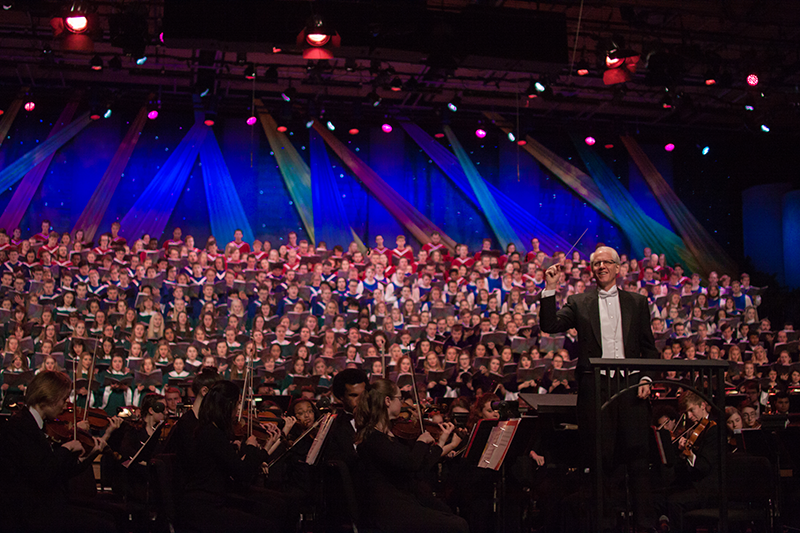
‘A little, radical church school’
“St. Olaf has always been a little, radical church school,” he said. “It was founded by people who wanted to be prepared for life in the new world.”
Armstrong has witnessed and experienced St. Olaf’s growing diversity firsthand. When he arrived on campus as a student 44 years ago, he was one of the few African-Americans.
“Everything was white,” he said — and not just the student body. When he first visited, the preceding January, the campus was covered with snow and the cafeteria that day was serving chicken, mashed potatoes and cauliflower.
“Even the food was white!” he said.
Now when he looks around the campus, he sees students and faculty from 79 countries representing a wide cross section of ethnicities.
In what ways does your organization reflect a changing world?
“When I hear colleagues say they don’t feel welcome, that hurts me,” Armstrong said. “I know the battles and have fought them.”
The Christmas Festival is about much more than the music — though that clearly gets the top billing. Liturgy and theology are equally important to the planning committee.
“The theme of the festival starts with theology and the mood of the country,” said the Rev. Dr. Matthew Marohl, the college’s pastor. “This year we focused on the [country’s] increased divisiveness. Students couldn’t go home for Thanksgiving without a checklist of topics they could discuss.”
Once a theme is selected, Marohl researches and compiles various scriptures that illustrate and convey the chosen message. He also writes an introduction to the program that touches on the festival’s theological content.

‘Good News of Great Joy’
For this year’s program, titled “Good News of Great Joy,” the introduction addressed the good news of binding up the brokenhearted and the joy of easing the load of the burdened.
The festival has become an important part of the college’s image, said John Ferguson, who retired in 2012 as conductor of the St. Olaf Cantorei and professor of organ and church music. Ferguson took part in the festival for 29 years, officially — and still participates in an unofficial capacity.
“People see us do the festival with the integrity that reflects the integrity of everything we do here,” he said.
What is your organization’s image and reputation in the community? What is known for?
In addition to being televised, broadcast on radio and livestreamed, the festival is carried by the armed forces TV and radio networks.
“From having been overseas as a student, I realize how much that connection to home can mean,” Ferguson said.
Obviously, the festival is also important to the students on campus. Not only do a fifth of the students participate in the event; they take part, committing to numerous rehearsals and four performances, at the worst possible time for college students, the weekend before final exams.
Ferguson said he knew that not much studying happens during festival weekend.
“That’s how much the students appreciate the opportunity to do this,” he said.
Later, they come back to the festival as alumni and realize all over again what the festival meant and continues to mean to them.
“When they find us afterward, they don’t know what to say,” Ferguson said. “They realize what an incredible experience they had.”
‘Consistently excellent’
Armstrong said the festival has managed to be consistently excellent over many years for a variety of reasons.
“The first is consistency in leadership,” he said.
The festival has had only four artistic directors in its 107 years — and the short-timer of those four served for 22 years. The festival’s founder, F. Melius Christiansen, was in charge for 32 years, and Armstrong, after 29 years, is fast closing in.
“I’m going to catch him,” he said with a smile.
The St. Olaf students have also played an important role. “We have always had wonderfully talented and really hardworking kids,” Armstrong said.
A liberal arts college with an emphasis on the arts, St. Olaf attracts young people who are more results-oriented than career-focused, he said.
“Through the arts and music, we create a community that is caring, passionate and intellectual,” he said. “Our students aren’t interested in being the ones who make the most money after they graduate. They want to make a difference.”
Members of the community strive to create a supportive atmosphere on campus.
“It’s a place where issues of faith and values permeate not just the religion department but the entire fabric of the institution,” he said. “One of the reasons I chose St. Olaf [as a student] was because of the values of this place, the love of neighbor.”
Changes in planning and infrastructure
When Armstrong took over the festival, he made a few changes in the infrastructure. For starters, he brought in some new blood to the planning committee, expanding it beyond the music department.
He added the college pastor to ensure that the festival had a basis in liturgy and Scripture. And he invited a representative of the art department to serve as visual designer.
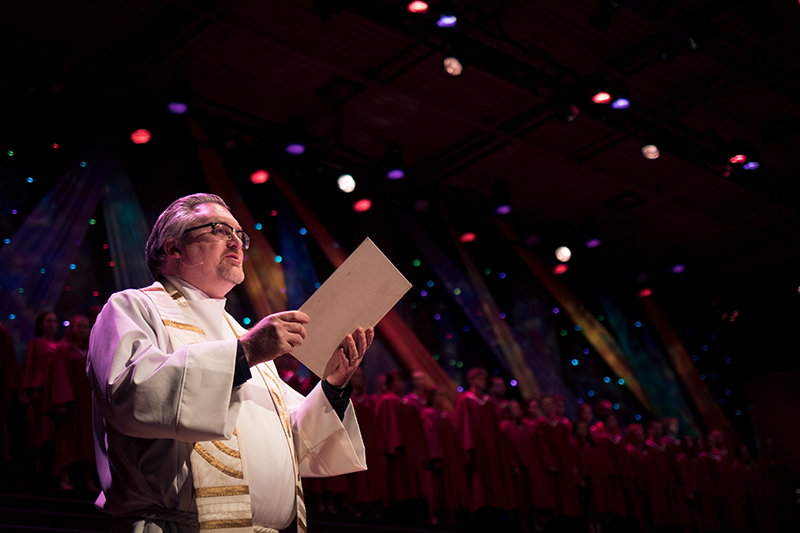
The school’s basketball arena is the only venue on campus large enough to hold the event, and Armstrong figured that getting a designer in on the ground floor could only help. This year, Christie Hawkins, the festival’s visual designer and set production chief, hung large colored banners behind the stage to create the impression of stained-glass windows.
Armstrong also changed the way the festival is planned.
Before, the planning committee would choose the music and then develop an appropriate theme. But Armstrong decided to do the opposite.
“I decided that we’d come up with the theme first and then express it through the music,” he said.
Almost as soon as one festival is over, planning starts for the next one. The first planning meeting for this year’s festival took place last January. In a few weeks, planning for the 2019 festival will begin.

“One reason is that we want things to still be fresh in our minds,” Armstrong said. “We want to go over whatever feedback we got.”
Dealing with the unexpected
But even with a year to plan, the unexpected can happen and things can change. In 2017, the committee jettisoned its original theme after a year that had been filled with racial unrest.
Several unarmed young black men across the nation, including one in Minneapolis, had been shot and killed by police. After a report of a racial incident on campus — which turned out to be unfounded — the students held a sit-in that shut down classes for a day. Other colleges in the state were having similar experiences.
“We were living in a mess,” Armstrong said.
The festival planners put together a new program based on social justice. That was also part of this year’s festival, although more subtly.
“Last year’s festival had lots of big [musical] numbers,” Marohl said. “This year, the first third was quite soft — but not soft in a weak sense. It was kindness and grace coming in sweetness.”
What does your organization do to help people set aside differences?
The power of music to make a difference — whether at St. Olaf College or in the world — should not be underestimated, Armstrong said. In fact, he’s convinced that if he could put together a choir from the members of the U.S. Congress, he could dissipate much of the rancor that marks modern politics.
“Choral singing is one of the last few places where people put aside their differences,” he said. “We have a lot of political views up there [in the choir]. We have lots of religious beliefs. But we can put aside what divides us, because when you are doing choral singing, you have to listen to the people around you.
“Music helps us find the common good, find the unison and find the harmony.”
Enjoy this content? Subscribe to our newsletters.
Questions to consider
Questions to consider
- What message does your community and the world need to hear this Christmas?
- How does your church or organization welcome others while honoring its own traditions?
- In what ways does your organization reflect a changing world?
- What is your organization’s image and reputation in the community? What is it known for?
- What does your organization do to help people set aside differences?
When the Rev. Kara Root came to Lake Nokomis Presbyterian Church in 2008, the congregation wasn’t exactly desperate.
“They were already past desperate,” Root said. “They went through that stage before I arrived.”
Nobody had joined the Minneapolis church in seven years. It had no children’s program, because it had no children. All the kids had aged out. On a good Sunday, maybe 30 people attended services in a sanctuary that once routinely held 300 worshippers. And the church’s once-comfortable endowment had just enough funds to last two more years — if they really pinched pennies.
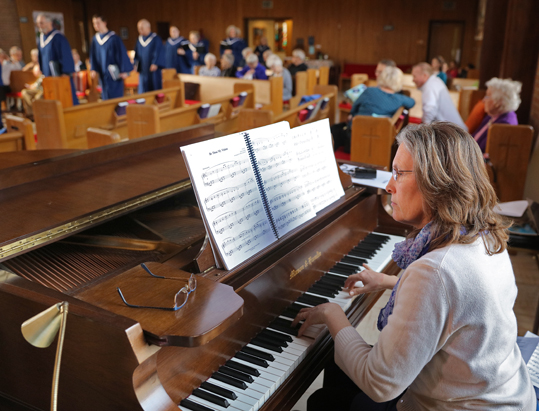
Lake Nokomis Presbyterian was dying, and everybody knew it — even if they weren’t quite ready to accept it. When Root realized the congregation wasn’t willing to let go — at least not yet — she knew it was the right place and the right time to suggest something radical.
“The people who had stayed were hardy adventurers,” she said. “They were ready to try new things. And I figured that if we went broke in 18 months instead of 24, what difference would it make?”
What would the circumstances have to be in order for your church or organization to make radical changes?
Strictly speaking, Root’s idea wasn’t new. In fact, it was thousands of years old. In a time when congregations are searching for new and different ways of being church, Root proposed that Lake Nokomis reclaim the ancient practice of Sabbath keeping and place it at the core of their identity as a congregation.
That might mean a day with no shopping trip to the mall. No pulling out a smartphone to check on work emails. No paying bills or balancing the checkbook.
And on some Sundays, under Root’s proposal, it would mean not even going to church.
“People weren’t coming every Sunday, anyway,” Root said.
A changed worship schedule
After a period of discernment, the congregation agreed to change its worship schedule and place Sabbath keeping at the heart of its life together.

Now, six and a half years later, the pattern they established is a strong, sustaining rhythm. On the first and third Sundays of the month, Lake Nokomis holds traditional worship services. On the alternate weekends, members gather on Saturday evenings for contemplative services that draw upon the same Scripture and sermon as the previous Sunday’s worship.
And on the second and fourth Sundays each month? They practice Sabbath, taking a rest from work, obligations, and even formal worship itself.
“I sleep in,” said Sue Goodspeed, a member of the worship committee. “I don’t get to do that often.”
Lisa Larges settles down with a cup of coffee and the Sunday edition of The New York Times. “I read the whole thing,” she said.

In months that have five Sundays, the congregation spends the extra Sunday participating in a community outreach event with a local nonprofit that offers mental health and educational services to children with emotional and behavioral issues.
The worship schedule is altered for holidays. Next Sunday may be the fourth Sunday in March — normally a Sabbath day at the church — but it will still be Easter at Lake Nokomis Presbyterian.
“Of course, we’re going to have services on Easter,” Root said.
How can your congregation keep Sunday worship from being “just another obligation?”
Nobody at the church is required to practice Sabbath, and though most congregants have readily joined in since the beginning, some are still less than enthusiastic. Dick Gross, a 50-year member, skips the Saturday services because it means driving after dark, and he misses the opportunity to worship on those weekends.
“To me, church is Sunday morning,” he said.
But having watched the congregation shrink over the years, he also appreciates the logic behind the changes.
“It seems to work for the younger people,” he said.

The decline reversed
Lake Nokomis Presbyterian is not on the cusp of becoming a megachurch, by any means, but the attendance trend has been reversed. Since the Sabbath practice was launched, the congregation has gained 18 new members and another dozen or so people who attend regularly. About 90 people are now members of the church; 40 to 70 attend Sunday worship services, and 12 to 25 the Saturday evening services.
Young families have joined the church, and the children’s program is back. “It’s great seeing kids running around the church again,” Root said.

And the church’s financial situation has improved. In fact, it donates 10 percent of its annual budget to neighborhood projects.
“One of the big questions for us was, how could we be a blessing for others,” Root said. “We’re financially stable. We’re just as much in the hole as we were before, but at least we’re not going any deeper.”
One of the biggest challenges for Lake Nokomis members has been how to explain Sabbath keeping to people outside the church. After spending a Sunday in retreat from the many obligations of modern life, members are often bombarded with questions:
“Why didn’t you return my phone call about the Monday meeting?”
“How could you not finish that PowerPoint presentation?”
“What do you mean your kid isn’t coming to soccer practice?”
A countercultural practice
That’s not surprising, said Dorothy C. Bass, the recently retired director of the Valparaiso Project on the Education and Formation of People in Faith and author of “Receiving the Day: Christian Practices for Opening the Gift of Time,” a book about Sabbath practices.
Practicing Sabbath is very countercultural, Bass said.
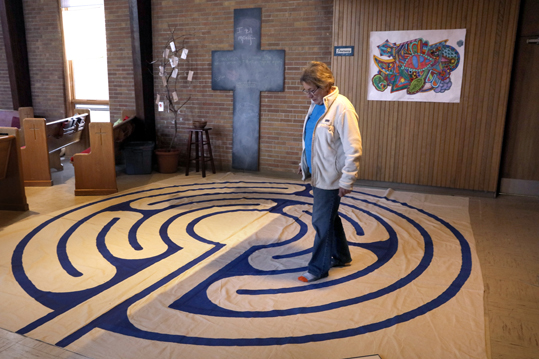
“The ethos of society now is hectic,” she said. “We’re obsessed with productivity in a way that infuses most people’s consciousness. … This has become so habitual that we don’t even realize how broken we are.”
In what ways does your congregation challenge cultural understandings of productivity and busyness? In what ways does it affirm them?
Root knows firsthand the knee-jerk guilt of breaking with societal norms. The first Sunday the church observed Sabbath, she and her family went for a walk through their neighborhood.
“We went past a church, and when I saw the parking lot full of cars, I felt like I was playing hooky,” she said.
The cultural ramifications are one reason that Bass was excited to hear about Lake Nokomis Presbyterian and its journey together. Many individuals have taken up Sabbath keeping in recent years, but it is rare for an entire congregation to take such significant steps to encourage one another in the practice, she said.
“Doing it collectively, communally, with somebody else — that’s why it’s really cool that a congregation is taking this on,” she said. “I don’t know of any individual who can say, ‘I’m going to grant myself this freedom.’ No, we’re going to need to do that with and for each other.”
The renewed interest in Sabbath practices among Christians started to surface about 20 years ago. Bass wrote her book in 2000; since then, the need for Sabbath has only grown stronger.
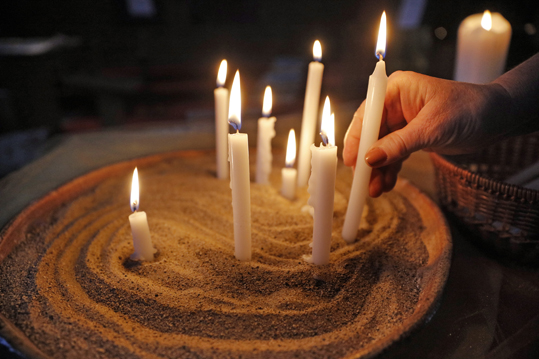
“I think the practice is more needed now than it was then,” Bass said. “We’ve lost touch with natural time. Now we have Internet time, which governs the economy and is 365, 24/7. I don’t think that’s the way we were meant to be as human beings.”
Sabbath at Lake Nokomis
At Lake Nokomis Presbyterian, the Sabbath Sundays are set aside “for rest and play, being instead of doing, connecting with God and others, and embracing the world with awareness and gratitude.”
Exactly what that entails is left up to each individual or family, but the church doesn’t recommend that participants drop off the radar completely, Root said. She suggests drawing a line between obligations and desires: do what you want to do, not what you feel that you have to do.
Members vary widely in how they make that distinction. Sabbath, like art, can be in the eye of the beholder. What one person considers a chore — spending hours in the kitchen preparing an elaborate meal, for instance, or toiling on one’s hands and knees tending a garden — is someone else’s notion of a perfect day.
“We have members who mow their lawn on Sundays,” Root said. “They like doing it.”
Youth sports are a typical source of conflict, even for Root and her family. With two children, the family came up with a rule to address the issue.
“If it’s a game, it’s fun, and we go,” she said. “If it’s a practice, it’s an obligation, and we don’t go.”
Not everything is that cut-and-dried, of course. Member Andy Cochrane focuses on not worrying about work.
“I’m not always successful,” he admitted. “But even if I don’t make it all day, doing it part of the day helps.”

Practicing Sabbath has had a profound effect on Root and her family, Root said.
“I’ll never forget what that first day felt like,” she said. “It felt like it was an eighth day. It felt like a gift. It gave me a palpable feeling of peaceful energy.”
Taking an entire day off ran counter to everything she’d ever experienced.
“I come from a robust line of multitaskers,” she said. “I was always trying to put 10 pounds in a 5-pound box. Now I’m focused on putting 5 pounds in a 5-pound box.”
Goofing off, good for the soul
Most of what the church members do on the Sabbath could be described as good, old-fashioned goofing off. That’s fine, Bass said. Goofing off can be good for the soul and the body. It’s not just common sense; the Bible actually calls for rest.
“It still is one of the Ten Commandments,” Bass said.
“It’s OK just to rest,” she said. “I believe that you can’t get through a week without having some type of Sabbath. Your body will break.”
In her book, Bass examined the theological, biblical and sociological influences on Sabbath and found three general approaches to the Christian Sabbath.
One is to celebrate creation. “It says in Genesis that God rested on the seventh day and looked at everything he did, and it was good,” she said.
Another focuses on liberation. “In Deuteronomy, it says ‘The Lord your God led you out of slavery.'”

The third involves being part of a community that commemorates the resurrection. “So get outdoors and celebrate creation. Do something that feels free and life-giving, and get together with people,” Bass said. “I like to say, ‘No church meetings [on the Sabbath], but church picnics are great.'”
What would an ideal Sabbath look like for you?
The Lake Nokomis congregation took to the Sabbath practice quickly. It was proposed as a one-year experiment, but “six months into it, we had changed so much that there was no going back,” Root said. She knew how deeply the practice had taken hold in the church when she sent an email to a member and got a note back chastising her for sending it on a Sunday afternoon.
Saturday services
The inauguration of the alternate-weekend Saturday evening services didn’t go nearly as smoothly — to put it mildly. The long periods of silence in the contemplative-style services left many members uncomfortable and fidgety.
“The first service was a disaster,” Root said. “It was almost painful. I came out of there saying, ‘This is not going to fly.'”
But they kept refining it until it did fly, bringing together pieces from the Sunday morning service, meditative elements from the Taizé community and the self-directed features of contemplative spirituality.
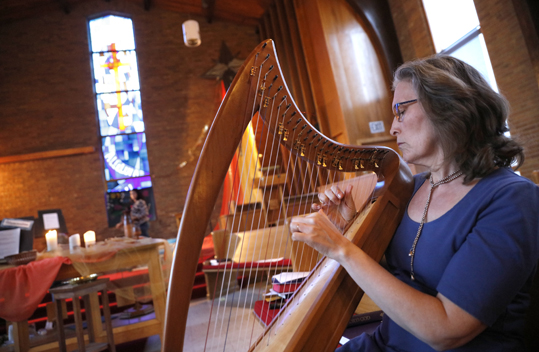
The hour-long service begins with Root speaking to the assembled membership, offering an abridged version of the previous Sunday’s sermon. Then the group breaks up. While music director Jeanne Rylander softly plucks a harp, some people meditate. Others visit various stations, where they can, for example, pray for troubled parts of the world, walk a labyrinth or simply rest. At one station, adults and children can color a banner that later will be hung in the church.
The Saturday evening program has enabled the congregation to reach out to worshippers who want something different from a traditional worship service but still like the direction that clergy can offer.
“We’re not a one-size-fits-all church,” Goodspeed said.
Even though the Saturday service repeats the Scripture and part of the sermon from the previous Sunday, some members like the different approaches so much that they attend both.
“I feel that I get something different out of it,” Larges said. “We hear the same Scripture, but we hear it in different ways.”
Ultimately, Root said, the goal of the Saturday services and the Sabbath practices is the same.
“Find ways you and God can commune,” she told the congregation on the eve of a recent Sabbath Sunday observation.
“If you stop, God will come to you,” she said. “You will experience something significant. And even if it happens on just one day, it will be worth it.”
Questions to consider
Questions to consider
- What is the most radical and beneficial change you could envision your church or organization making? What would the circumstances have to be in order to make those changes?
- What is the core of your congregation’s identity?
- In what ways, if any, can Sunday worship become just one more obligation on a list of obligations? How can your congregation keep Sunday worship from being “just another obligation?”
- How does your congregation challenge cultural understandings of productivity and busyness? How does it affirm them? How can your congregation help members realize their brokenness and rethink those and other cultural assumptions?
- What activities and obligations would you give up if you were to practice Sabbath? What would an ideal Sabbath look like for you?

